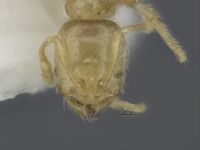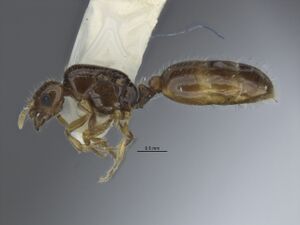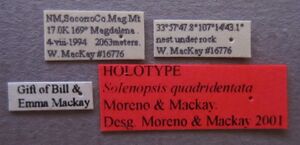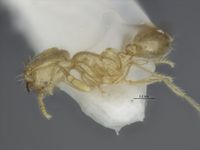Solenopsis quadridentata
| Solenopsis quadridentata | |
|---|---|

| |
| Scientific classification | |
| Kingdom: | Animalia |
| Phylum: | Arthropoda |
| Class: | Insecta |
| Order: | Hymenoptera |
| Family: | Formicidae |
| Subfamily: | Myrmicinae |
| Tribe: | Solenopsidini |
| Genus: | Solenopsis |
| Species complex: | molesta |
| Species: | S. quadridentata |
| Binomial name | |
| Solenopsis quadridentata Pacheco, Mackay & Moreno, 2013 | |
Solenopsis quadridentata nests under stones and workers were captured via pitfall traps in New Mexico. It occurs in pinyon-juniper and grey oak forests in light brown gravel soils. Brood was present in a nest in August, and a nest had a single queen.
Identification
A New World thief ant that is a member of the molesta species complex. (Key to New World Solenopsis Species Complexes)
Pacheco and Mackay (2013) – Worker - This is a concolorous pale yellow species with angular lateral clypeal teeth. The hairs on the posterior tibiae are typically appressed or suberect. There is a translucent tooth present at the subpeduncular process. Queen - The queen is concolorous golden brown. The diagnostic character of the queen is that both the lateral and extralateral clypeal teeth are well developed. The head and pronotum have coarse punctures. The metap1euron, petiole and postpetiole have horizontal striae.
The workers of S. quadridentata can be confused with those of Solenopsis salina and Solenopsis texana. Solenopsis quadridentata can be separated from S. salina based on the degree of development of the lateral clypeal teeth. Solenopsis quadridentata has angular lateral clypeal teeth whereas S. salina has blunt, inwardly curved clypeal lateral teeth in most cases. This trait will separate this species from the closely related S. texana, which has straight, thick, blunt teeth that rarely bend inward. The punctures on the head of S. quadridentata are coarse, which also separates this species from S. texana as well as Solenopsis molesta (where the punctures are small and difficult to see). Solenopsis molesta workers are consistently larger (total length 1.5-1.7 mm) compared to 1.38-1.50 for S. quadridentata.
The queen of this species may be confused with queens from the fugax species complex as it has four sharp clypeal teeth, but is recognized by its relatively small size (TL 5.58 mm), wide head and thin subpeduncular flange. The queen may be confused with S. molesta. However, S. molesta queens are nearly always concolorous yellow and have two well defined lateral clypeal teeth instead of the four well developed teeth found with S. quadridentata.
Keys including this Species
Distribution
United States: New Mexico.
Latitudinal Distribution Pattern
Latitudinal Range: 34.09638889° to 33.96327778°.
| North Temperate |
North Subtropical |
Tropical | South Subtropical |
South Temperate |
- Source: AntMaps
Distribution based on Regional Taxon Lists
Nearctic Region: United States (type locality).
Distribution based on AntMaps
Distribution based on AntWeb specimens
Check data from AntWeb
Countries Occupied
| Number of countries occupied by this species based on AntWiki Regional Taxon Lists. In general, fewer countries occupied indicates a narrower range, while more countries indicates a more widespread species. |

|
Estimated Abundance
| Relative abundance based on number of AntMaps records per species (this species within the purple bar). Fewer records (to the left) indicates a less abundant/encountered species while more records (to the right) indicates more abundant/encountered species. |

|
Biology
Castes
Males have yet to be collected.
   
| |
| . | |
Nomenclature
The following information is derived from Barry Bolton's Online Catalogue of the Ants of the World.
- quadridentata. Solenopsis quadridentata Pacheco, Mackay & Moreno, in Pacheco & Mackay, 2013: 285, figs. 257-260 (w.q.) U.S.A. (New Mexico).
- Type-material: holotype queen, 5 paratype workers.
- Type-locality: holotype U.S.A.: New Mexico, Socorro County, Magdalena Mt, 17 km. Magdalena, 33°57’47.8’’N, 107°14’43.1’’W, 2063 m., 4.viii.1994, #16774 (W. Mackay); paratypes with same data.
- Type-depositories: MCZC (holotype); MCZC, WEMC (paratypes).
- Distribution: U.S.A.
Unless otherwise noted the text for the remainder of this section is reported from the publication that includes the original description.
Description
Worker
Measurements (n=5). TL 1.38-1.50 (1.44); HL 0.420-0.450 (0.440); HW 0.360-0.390 (0.383); EL 0.036; ED 0.030; SL 0.306-0.342 (0.314); FSL 0.120-0.132 (0.125); CI 85.7-89.0 (86.9); SI 68.9-76.0 (71.4); PL 0.090; PW 0.108-0.120 (0.114); PI 75.0-83.3 (79.1); PPL 0.102-0.108 (0.104); PPW 0.138; PPI 73.9-78.3 (75.4); WL 0.300-0.306 (0.302); PSL 0.030; PSW 0.024.
Concolorous pale yellow; head longer than wide, sides of head straight, posterior border slightly concave, with coarse punctures, larger than hairs that originate from them; lateral clypeal teeth angular, medial tooth absent, extralateral teeth poorly developed; scape extends slightly more than 2/3 length of head, funicular segments 3-8 short; eye small, brown, at least three ommatidia; punctures on mesosoma and gaster less coarse than those of head with surfaces between punctures smooth and shiny, pronotum and mesopleuron smooth and shiny, metapleuron with horizontal striae, notopropodeal suture depressed with groove breaking sculpture of mesosoma; posterior border of propodeum rounded, propodeal spiracle small; petiole wider than postpetio1e in profile with rounded, triangular node, thin, translucent tooth present on subpeduncular process; postpetiolar node oval; sculpture of petiole and postpetiole smooth and shiny.
Hairs of various lengths (~0.020-0.090 mm) present on all body surfaces; erect and suberect hairs on head, antenna very hairy, scape with few suberect hairs, pronotum with erect hairs projecting above outline, as seen in profile, mesonotum with erect hairs (0.070 mm) above profile, propodeum, petiole, postpetiole with suberect that curve posteriorly, gaster with suberect hairs on outline of first tergum.
Queen
Measurements (n=1). TL 5.58; HL 0.660; HW 0.630; EL 0.192; ED 0.180; MOL 0.060; MOD 0.078; SL 0.480; FSL 0.276; CI 95.5; SI 72.7; PSL 0.036; PSW 0.036; PL 0.165; PW 0.288; PI 57.3; PPL 0.240; PPW 0.342; PPI 70.2; WL 1.08.
Concolorous golden brown, slender bodied gyne; coarse cephalic punctures; head longer than wide; lateral and extralateral clypeal teeth sharp, well developed; clypeal carinae well developed; frontal lobes with vertical striae; medium sized eyes; medial ocellus medium sized; scape reaching about 2/3 to posterior lateral corner of head; pronotum coarsely punctate, but smooth and shiny between punctures, mesopleuron smooth and shiny, horizontal striae on metapleuron; petiole wider than postpetiole in profile with rounded, triangular node, horizontal striae present, thin flange on subpeduncular process; postpetiolar node oval, covered basally with horizontal striae.
Hairy with erect and suberect hairs covering all body surfaces; head, mesosoma, petiole, postpetiole and gaster heavily pilose with hairs of various lengths (0.030-0.120 mm); scape heavily pilose with several longer hairs present of 0.120 mm in total length.
Type Material
Holotype queen (Museum of Comparative Zoology) and 5 paratype workers (William and Emma Mackay Collection, MCZC), USA, New Mexico, Socorro Co., Magdalena Mt. 17.0K Magdalena, 33°57'47.8''N 107°14'43.1"W, 2063 m, 04-viii-1994, W. Mackay #16774.
References
References based on Global Ant Biodiversity Informatics
- Pacheco J. A., and W. P. Mackay. 2013. The systematics and biology of the New World thief ants of the genus Solenopsis (Hymenoptera: Formicidae). Lewiston, New York: Edwin Mellen Press, 501 pp.

